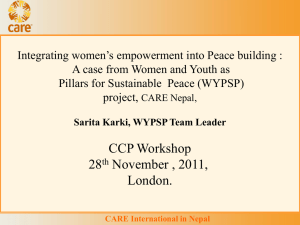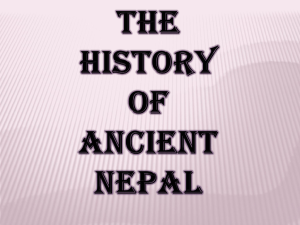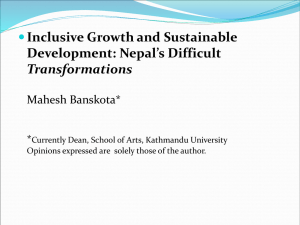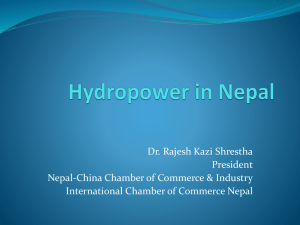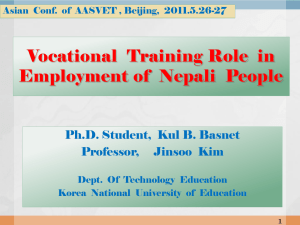Presentation - International Conference on Technology
advertisement
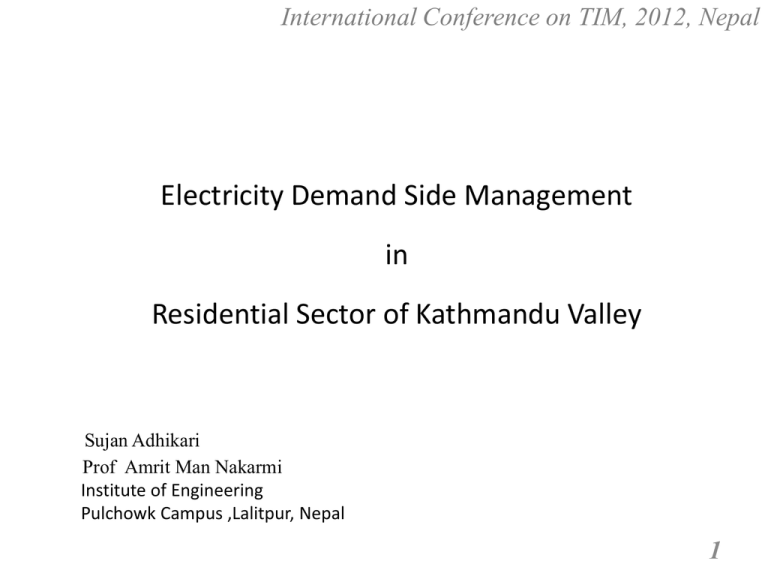
International Conference on TIM, 2012, Nepal Electricity Demand Side Management in Residential Sector of Kathmandu Valley Sujan Adhikari Prof Amrit Man Nakarmi Institute of Engineering Pulchowk Campus ,Lalitpur, Nepal 1 International Conference on TIM, 2012, Nepal Research Objectives • Determine the current electricity consumption pattern of residential sector of Kathmandu Valley. • Forecast the electricity demand of residential sector Kathmandu Valley. • To propose suitable Demand Side Management strategies. 2 International Conference on TIM, 2012, Nepal Electricity consumption pattern • 13% of energy consumed in Nepal is through commercial source (WECS,2010) • 48% of population have access to electricity of which 8% of people reside in rural areas (MOF,2007) • Increasing residential consumer base • Decreasing per capita electricity consumption Year Total No of Domestic Average Per capita Domestic Electricity Household electricity Consumers Consumption Size consumptio (GWh) n (KWh) 2011 1948968 1170.77 4.7 127.81 2001 713307 518.36 5.44 133.58 (Source: NEA Annual Report, 2011; CBS Preliminary Survey, 2011) 3 International Conference on TIM, 2012, Nepal Concept of Demand Side Management • Demand Side Management Demand side management (DSM) also known as Energy demand management is the modification of consumer demand for energy through various methods. • Alternative to supply side “overspending” in energy systems (NILSSON, 2007). 4 International Conference on TIM, 2012, Nepal Residential Sector • In context of Nepal, residential accounts for the major share of energy consumption (89.1%) (Wecs, 2010). • 44% of the total electricity consumption in Nepal is in residential sector Commercial 7% Agricultural 2% Residential 44% Share of electricity consumption other 9% Transport 0.20% Industrial 38% 5 International Conference on TIM, 2012, Nepal Kathmandu Valley • Limitations Urban areas of Kathmandu Valley. Municipal boundaries of Kathmandu Valley considered as the urban limits. • Electricity consumption characteristics 29.2% of total electricity distributed by the Nepal Electricity Authority is consumed in Kathmandu Valley alone. (NRB,2012) Kathmandu municipalities alone constitutes about 36% of the total urban households (CBS,2011) 6 International Conference on TIM, 2012, Nepal Methodology • Questionnaire Design • Sample Design • Household Survey • Analysis and conclusion 7 International Conference on TIM, 2012, Nepal Questionnaire Design • Household Characteristics Characteristics Household Income Description Total household income per month Nepalese Rupees (Nrs) Household size Number of individuals in the household Rooms No of Children Number of rooms in the household Number of children in the household • Variables Number of Appliance Operating hour of the Appliance Rating of the appliance 8 International Conference on TIM, 2012, Nepal Regression Result • Average electricity consumption was regressed with the household characteristics Coefficients -61.28 Standard Error 29.20 t Stat -2.10 0.0018 0.0002 7.49 FS 8.81 7.16 1.23 NC 21.90 16.40 1.34 6.85 3.43 2.00 ID Intercept Monthly Income (Nrs) MI Family size Number of children Number of rooms R R2= 0.765 Therefore the regression equation is E= -61.28+0.002 MI + 8.811FS+21.9 NC+6.85R 9 International Conference on TIM, 2012, Nepal Sample Design • Size of the sample, n 2*N*(1-P) ME2(N-1) + ( 2*P*(1-P)) Source: Source: Morgan et all.1970 Where n = required sample size 2 = Chi square for the specified confidence level at 1 degree of freedom N = Population size ME = Desired Marginal error (expressed as a proportion) 10 International Conference on TIM, 2012, Nepal Household Survey Household sample surveys have become a key source of data on social phenomena in the last 60-70 years S.N Income 1 2 <15,000 Poorest 15,000-25,000 Second 3 25,000-40,000 Third 4 40,000-80,000 Fourth 5 80,0002,00,000 Total Class Qty of Share electricity used (%) (Units/Month) 47.9 8 74.7 40 103 39 132 9 200 4 100 Richest 11 International Conference on TIM, 2012, Nepal LEAP Modelling Framework Modeling Conditions The base year for the model was 2012 and horizon of 18years was used, thus modeling until 2030. Discount rate used in model was 12%. 12 International Conference on TIM, 2012, Nepal LEAP Modelling Framework Projection • Household projection Y=119519*exp (0.6025*x) where x is the number of year. Year 2012 2015 2020 2025 2030 Households No (Lakhs) 3.9 4.9 6.7 9.2 12.6 • Household income • Appliance ownership Energy ladder hypothesis Regression between household income and appliance number Result showing R2 value greater that 75% is considered 13 International Conference on TIM, 2012, Nepal Scenario Selection • Business As Usual (BAU) Scenario 5.4% household income growth rate • Medium Income Growth (MG) scenario 5.5 % national GDP growth rate 8.7% household income growth rate • High Income Growth (HG) scenario 7% national GDP growth rate 11.1% household income growth rate • DSM Scenario 14 International Conference on TIM, 2012, Nepal Scenario Result Electricity Consumption (Million Kilowatt Hours) Scenario 2012 2015 2020 2025 2030 HG 1252 1816 3155 5368 9066 MG 1252 1766 2952 4853 7909 BAU 1252 1691 2660 4148 6427 Scenario Comparison Electricity Consumption (Million Kilowatt Hours) 10000 BAU-9.5% MG-10.7% HG- 11.6% 8000 6000 4000 2000 0 2010 2015 2020 HG MG 2025 Year BAU 2030 2035 15 International Conference on TIM, 2012, Nepal DSM Criteria • • • DSM Options DSM 1 Replacement of all of the widely used incandescent lamps of rated power 40 W and 100 W to CFL of rated power 20W in the poorest households by the end of 2030. Replacement of widely used 36 W fluorescent lights and 40 W and 100 W incandescent light in the above poorest households by LED lights of 13 W by the end of 2030. DSM 2 Replacement of electrical water heater by solar water by the end of 2030. DSM 3 All light will be replaced by solar powered LED lights. 16 International Conference on TIM, 2012, Nepal DSM Result (Energy Savings) • Electricity consumption under DSM implementation scenario was compared with the MG scenario • DSM1 7320.6 GWh of electricity savings by the end of modeling period. • DSM 2 146.2 GWh of electricity savings by the end of modeling period. • DSM3 7885 GWh of electricity can be saved across the modelling period. 17 International Conference on TIM, 2012, Nepal DSM Results (Economic Analysis) B/C Ratio Discount rate of 12% Benefit – NPV of avoided supply cost Cost- NPV of programme cost The B/C of the DSM1 programme was 5.09, 4.43, 7.61, 11.38 and 51.2 for poorest, second, third, fourth and richest class of households respectively The B/C of the DSM2 programme was 0.51, 0.3, 0.5, 0.57 and 0.25 for poorest, second, third, fourth and richest class of households respectively The B/C of the DSM3 programme was 1.3, 2.3, 3.9, 7.8 and 54.8 for poorest, second, third, fourth and richest class of households respectively 18 International Conference on TIM, 2012, Nepal Conclusion • Electricity consumption mostly depend on household income. • Second and Third is the highest electricity consuming category of households and continue in future on all scenarios • Implementation of effective DSM options would assist in managing Nepal’s electricity deficit. 19 International Conference on TIM, 2012, Nepal Recommendations • Government should consider the adverse effects of unchecked increasing electricity consumption trend and create separate DSM unit to ensure coordinated efforts for DSM projects implementation. • Major steps should be taken to establish robust database of energy consumption pattern of the region, management of available secondary information from various relevant authorities and carries out frequent customer perception survey and energy consumption pattern. • Detailed energy audit survey needed for very high end households with higher electricity consumption • Special attention has to be given to the no cost/low cost energy conservation measures such as use of daylight and other measures like energy labeling on electric cookers ,Refrigerators etc 20 International Conference on TIM, 2012, Nepal Thank You 21


